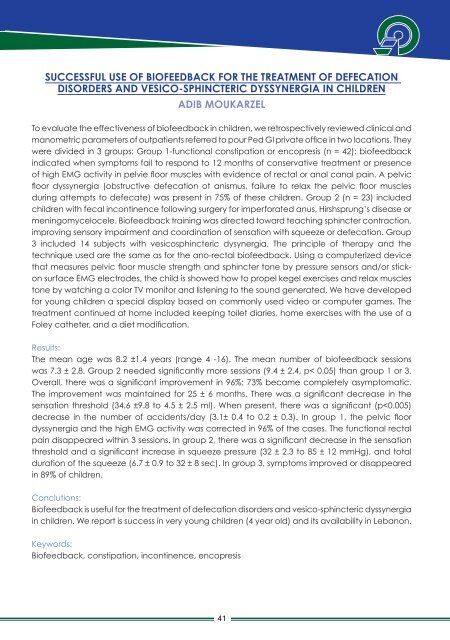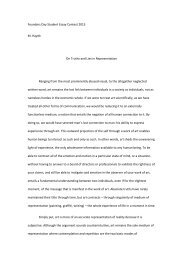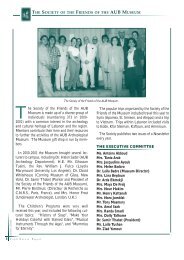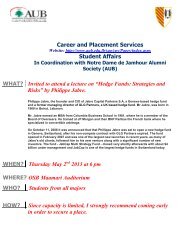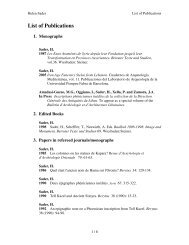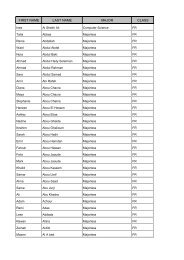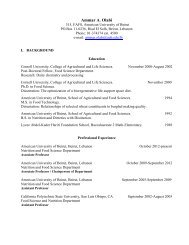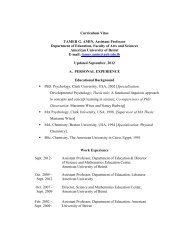The IX t h Makassed Medical Congress - American University of Beirut
The IX t h Makassed Medical Congress - American University of Beirut
The IX t h Makassed Medical Congress - American University of Beirut
Create successful ePaper yourself
Turn your PDF publications into a flip-book with our unique Google optimized e-Paper software.
SUCCESSFUL USE OF BIOFEEDBACK FOR THE TREATMENT OF DEFECATION<br />
DISORDERS AND VESICO-SPHINCTERIC DYSSYNERGIA IN CHILDREN<br />
ADIB MOUKARZEL<br />
To evaluate the effectiveness <strong>of</strong> bi<strong>of</strong>eedback in children, we retrospectively reviewed clinical and<br />
manometric parameters <strong>of</strong> outpatients referred to pour Ped GI private <strong>of</strong>fice in two locations. <strong>The</strong>y<br />
were divided in 3 groups: Group 1-functional constipation or encopresis (n = 42): bi<strong>of</strong>eedback<br />
indicated when symptoms fail to respond to 12 months <strong>of</strong> conservative treatment or presence<br />
<strong>of</strong> high EMG activity in pelvie floor muscles with evidence <strong>of</strong> rectal or anal canal pain. A pelvic<br />
floor dyssynergia (obstructive defecation ot anismus, failure to relax the pelvic floor muscles<br />
during attempts to defecate) was present in 75% <strong>of</strong> these children. Group 2 (n = 23) included<br />
children with fecal incontinence following surgery for imperforated anus, Hirshsprung’s disease or<br />
meningomycelocele. Bi<strong>of</strong>eedback training was directed toward teaching sphincter contraction,<br />
improving sensory impairment and coordination <strong>of</strong> sensation with squeeze or defecation. Group<br />
3 included 14 subjects with vesicosphincteric dysynergia. <strong>The</strong> principle <strong>of</strong> therapy and the<br />
technique used are the same as for the ano-rectal bi<strong>of</strong>eedback. Using a computerized device<br />
that measures pelvic floor muscle strength and sphincter tone by pressure sensors and/or stickon<br />
surface EMG electrodes, the child is showed how to propel kegel exercises and relax muscles<br />
tone by watching a color TV monitor and listening to the sound generated. We have developed<br />
for young children a special display based on commonly used video or computer games. <strong>The</strong><br />
treatment continued at home included keeping toilet diaries, home exercises with the use <strong>of</strong> a<br />
Foley catheter, and a diet modification.<br />
Results:<br />
<strong>The</strong> mean age was 8.2 ±1.4 years (range 4 -16). <strong>The</strong> mean number <strong>of</strong> bi<strong>of</strong>eedback sessions<br />
was 7.3 ± 2.8. Group 2 needed significantly more sessions (9.4 ± 2.4, p< 0.05) than group 1 or 3.<br />
Overall, there was a significant improvement in 96%; 73% became completely asymptomatic.<br />
<strong>The</strong> improvement was maintained for 25 ± 6 months. <strong>The</strong>re was a significant decrease in the<br />
sensation threshold (34.6 ±9.8 to 4.5 ± 2.5 ml). When present, there was a significant (p


